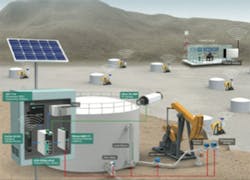Remote wellhead operators and mobile fracking companies currently use time-tested cellular communication technology to link various extraction points to wireless clients. This approach allows for coordinated, continuous communication and status alerts to be sent between field, transport and control operations.
Here’s an example of how this plays out in a typical industry scenario at one oil and gas well service company in the U.S.: The company uses a fleet of pump trucks to pump massive volumes of cement and water-based fracturing fluids into wells to prevent groundwater contamination and reduce fracture stimulation expenses in its shale gas service work. Because these pump trucks are deployed at several sites throughout the country, he company needed a way to remotely monitor all of the pump trucks from a mobile command center.
To ensure that the mobile trucks can monitor chemical levels, pressure and temperature in real time—with support from a central control room off-site—operators depend on the mounting of cellular modules on each extraction point, as well as each mobile truck. This safe, mobile and exact control capability is what the Industrial Internet of Things looks like in practice.
Enabling this service is Moxa’s approach to field-to-control network design, which emphasizes the use of both fiber and cellular wireless networks to facilitate proper control between the various sensors at each pipe casting and pump station, as well as the control HMI. Without this level of connectivity, advanced sensor technology lacks the ability to bring real-time meta- data to the HMI and central server.
In this application, Moxa’s cellular solution was implemented because oil and gas wells are seldom located close enough to an existing Ethernet network to deploy 802.11 access points. In addition, the pump trucks are usually deployed at hard-to-wire remote locations without an established network. Using existing cellular network coverage, the well operator can achieve system communications requirements.
Moxa’s ATEX-certified AWK-3121 (802.11a/b/g AP/ bridge/client) was installed on each pump truck and the mobile control center. By installing a wireless access point and a client on each of the pump trucks, engineers were able to access the pump trucks from the mobile control center. In addition, the access points on each of the pump trucks allow nearby laptops and wireless devices to connect to the same network and provide network redundancy if failure of an AWK-3121 occurs.
An OnCell G3110-HSPA is also installed on the mobile control center and is configured with a private IP address. All Moxa IP gateways and routers are equipped with OnCell Central Manager and can be accessed remotely. Moxa’s OnCell Central Manager eliminates the private IP barrier and allows private IP accessibility over the Internet for unrestrained mobility of the wireless network.
Moxa’s TurboChain and TurboRoaming protocol technology allow for redundant high-availability network expansion of Ethernet and wireless networks as these applications expand over time.
System requirements
To deploy a similar field-to-control network for your operation, here’s the basic technology outline:
- A wireless solution is required for a mobile control center to communicate with multiple hard-to-wire locations.
- Communication equipment must be weatherproofed to with- stand -40 to 70 °C temperatures with ATEX, IECex and UL approvals for hazardous environments.
- A mobile communication architecture is required for remote access of wireless devices and multiple pump trucks at each remote location.
- Scalable and fail-safe redundant wireless and Ethernet network integration is also required.
Moxa technologies were selected for remote and harsh environment oil and gas applications detailed above because:
- UL C1D2/ATEX Zone 2 certifications have been granted to Moxa’s AWK-3121 for protection against extreme climate and explosive gases.
- Moxa provides complete industrial wireless networking solutions, including IEEE 802.11a/b/g standards, wide temperature, industrial certification, and GSM/GPRS/EDGE/WCDMA/UMTS cellular technology. Devices can be connected to a wireless network with Moxa’s industrial-grade wireless AP or cellular IP gateway products.
- Moxa’s OnCell Central Manager technology (available with the OnCell G3110-HSPA) unlocks remote access to devices behind a private IP address, allowing for configuration, management and monitoring of the system over the Internet.
About the Author
Thomas Nuth
Global Oil & Gas Market Manager, Moxa

Leaders relevant to this article:
